
How to Use TP4056 lithium ion battery charging module: Examples, Pinouts, and Specs
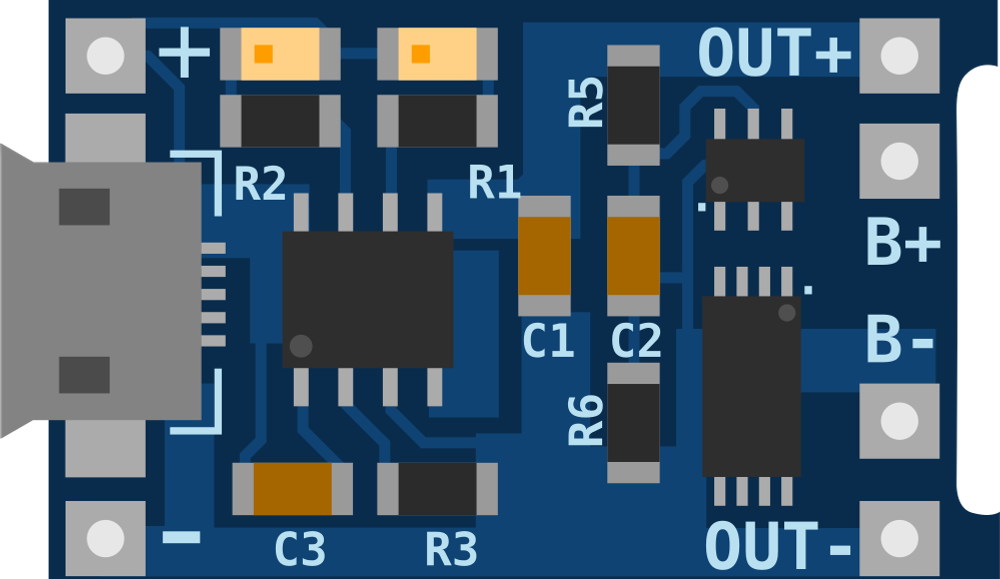
 Design with TP4056 lithium ion battery charging module in Cirkit Designer
Design with TP4056 lithium ion battery charging module in Cirkit DesignerIntroduction
The TP4056 is a linear battery charger IC designed for charging single-cell lithium-ion batteries. It operates using constant current (CC) and constant voltage (CV) charging modes, ensuring efficient and safe charging. The module is equipped with built-in overcharge protection, thermal regulation, and reverse polarity protection, making it a reliable choice for battery-powered applications.
Explore Projects Built with TP4056 lithium ion battery charging module
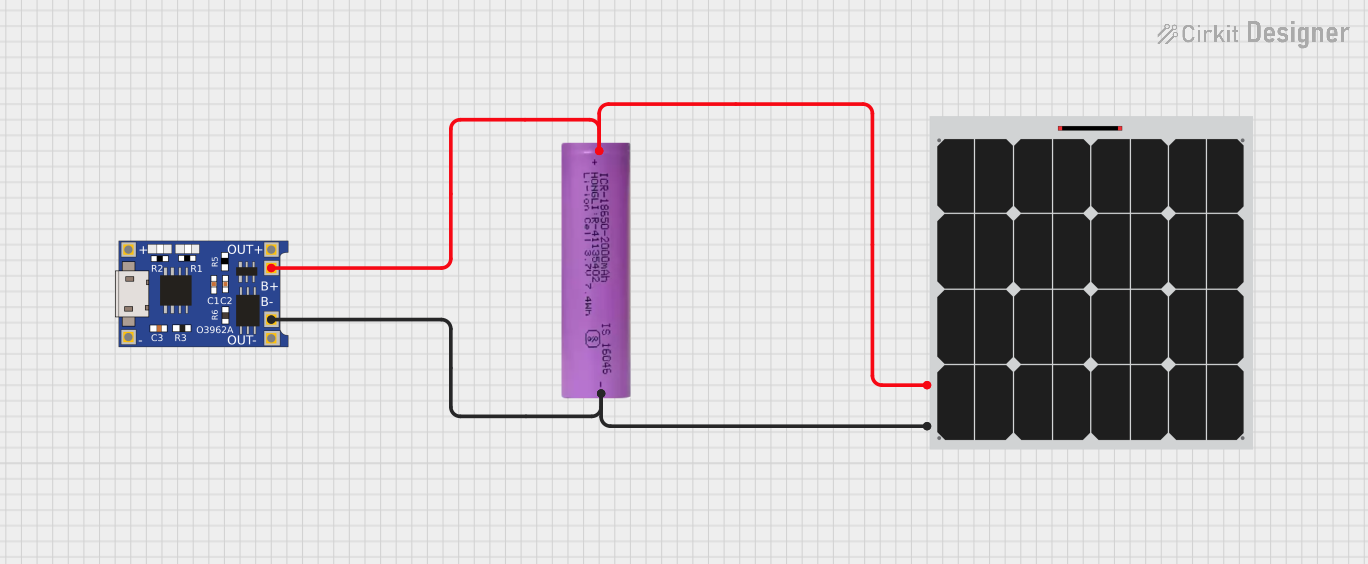
 Open Project in Cirkit Designer
Open Project in Cirkit Designer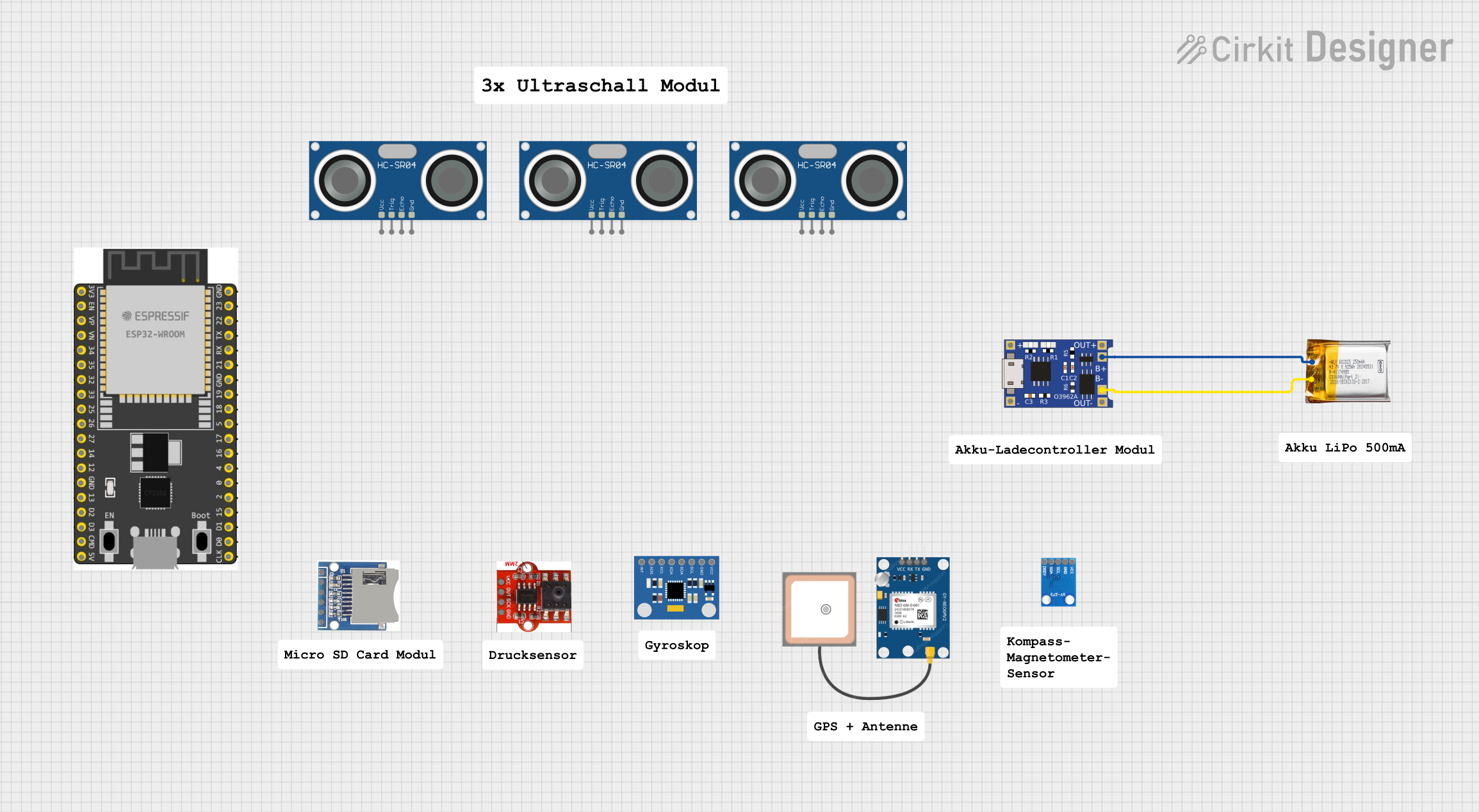
 Open Project in Cirkit Designer
Open Project in Cirkit Designer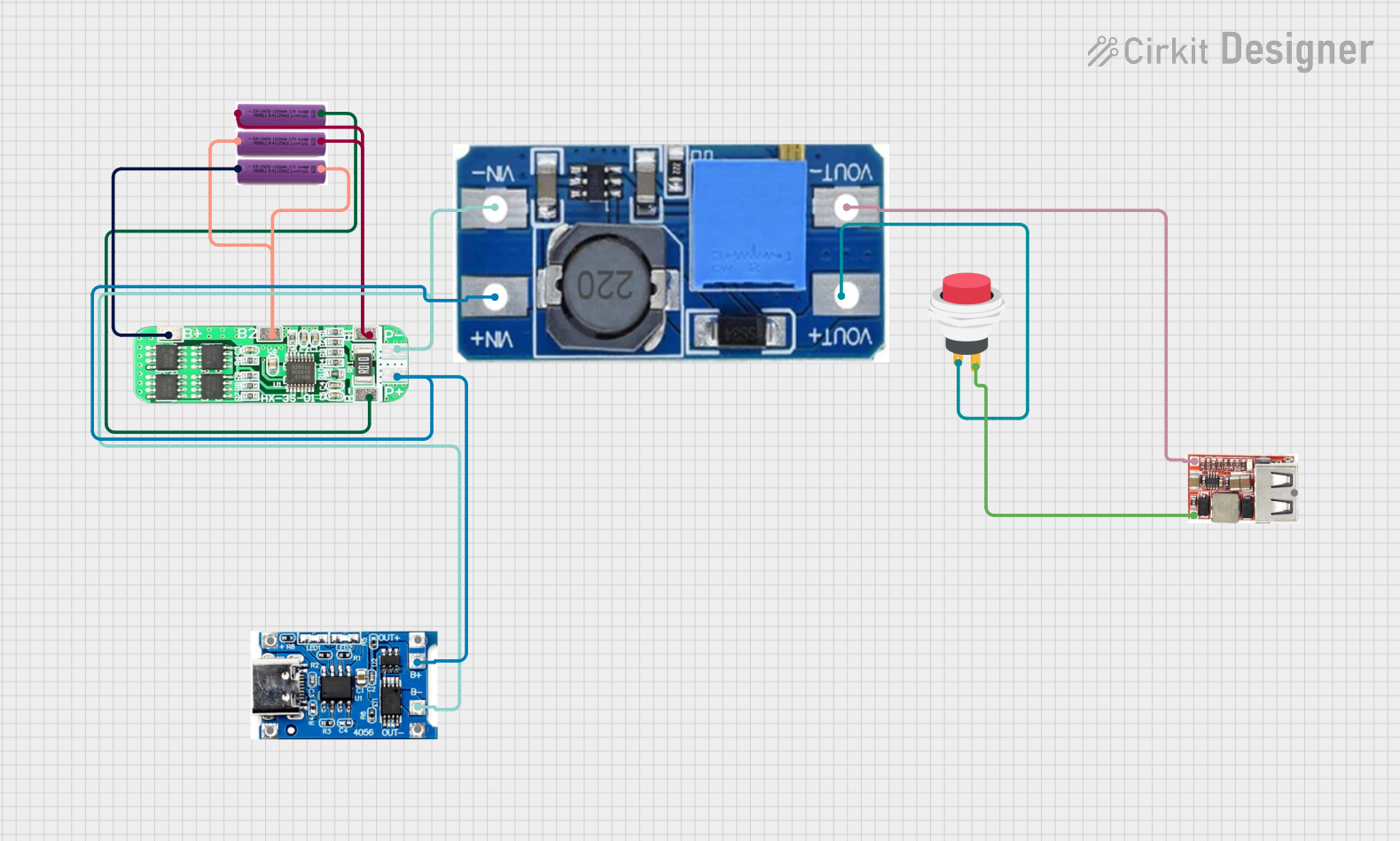
 Open Project in Cirkit Designer
Open Project in Cirkit Designer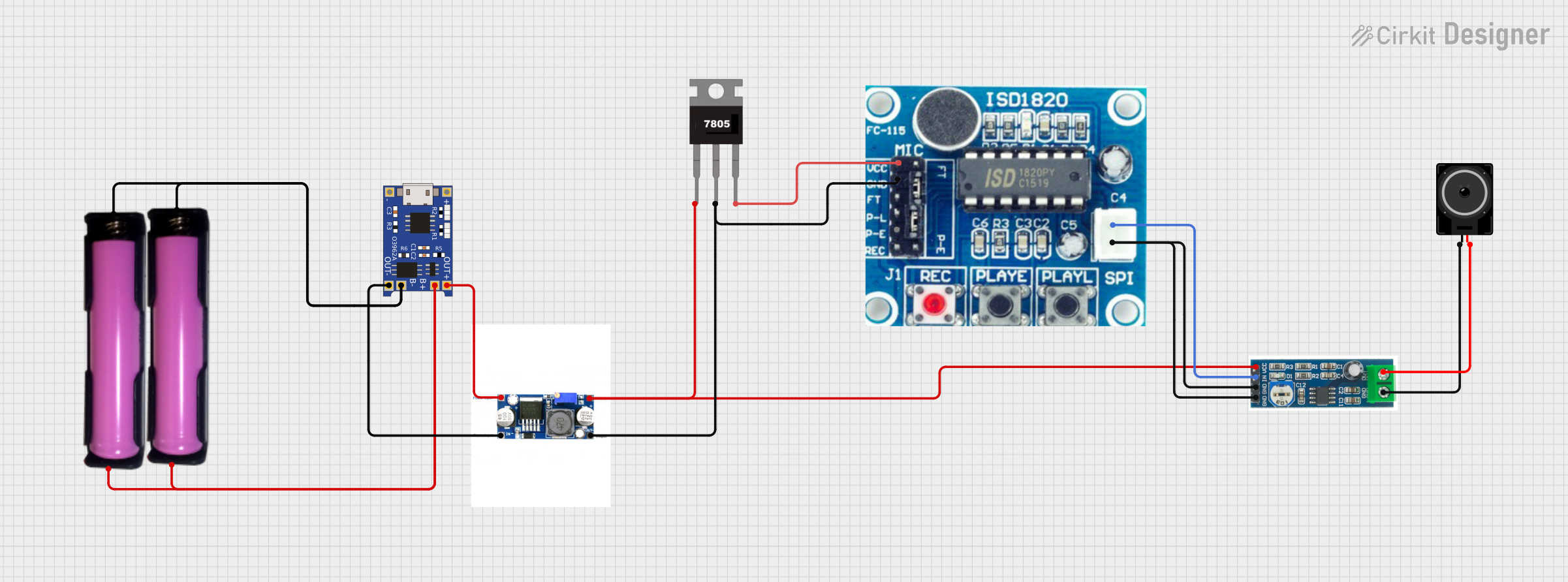
 Open Project in Cirkit Designer
Open Project in Cirkit DesignerExplore Projects Built with TP4056 lithium ion battery charging module

 Open Project in Cirkit Designer
Open Project in Cirkit Designer
 Open Project in Cirkit Designer
Open Project in Cirkit Designer
 Open Project in Cirkit Designer
Open Project in Cirkit Designer
 Open Project in Cirkit Designer
Open Project in Cirkit DesignerCommon Applications and Use Cases
- Charging single-cell lithium-ion or lithium-polymer batteries
- Power banks and portable chargers
- DIY electronics projects
- Wearable devices
- IoT devices and embedded systems
Technical Specifications
The TP4056 module is designed to provide a simple and efficient solution for charging lithium-ion batteries. Below are its key technical details:
Key Technical Details
| Parameter | Value |
|---|---|
| Input Voltage Range | 4.5V to 5.5V |
| Charging Voltage | 4.2V ± 1% |
| Maximum Charging Current | Adjustable (default: 1A) |
| Charging Method | Constant Current / Constant Voltage (CC/CV) |
| Operating Temperature Range | -10°C to +85°C |
| Protection Features | Overcharge, Overcurrent, Reverse Polarity, Thermal Regulation |
Pin Configuration and Descriptions
The TP4056 module typically has six pins. Below is the pinout and description:
| Pin Name | Description |
|---|---|
| IN+ | Positive input voltage (4.5V to 5.5V, typically connected to USB 5V) |
| IN- | Negative input voltage (ground) |
| BAT+ | Positive terminal of the lithium-ion battery |
| BAT- | Negative terminal of the lithium-ion battery |
| OUT+ | Positive output voltage (connected to the load, optional) |
| OUT- | Negative output voltage (connected to the load, optional) |
Note: Some TP4056 modules include additional pins for status LEDs (e.g., CHRG and STDBY) to indicate charging and standby states.
Usage Instructions
How to Use the TP4056 Module in a Circuit
Connect the Input Voltage:
- Connect a 5V DC power source (e.g., USB power) to the
IN+andIN-pins. - Ensure the input voltage is within the range of 4.5V to 5.5V to avoid damaging the module.
- Connect a 5V DC power source (e.g., USB power) to the
Connect the Battery:
- Attach the positive terminal of the lithium-ion battery to the
BAT+pin. - Attach the negative terminal of the battery to the
BAT-pin.
- Attach the positive terminal of the lithium-ion battery to the
Optional Load Connection:
- If you want to power a load while charging the battery, connect the load to the
OUT+andOUT-pins.
- If you want to power a load while charging the battery, connect the load to the
Monitor Charging Status:
- Use the onboard LEDs (if available) to monitor the charging process:
- Red LED: Charging in progress.
- Blue/Green LED: Charging complete or standby mode.
- Use the onboard LEDs (if available) to monitor the charging process:
Important Considerations and Best Practices
Adjusting the Charging Current:
- The default charging current is 1A. To adjust it, replace the onboard resistor connected to the
PROGpin. Use the formula: [ I_{CHG} = \frac{1200}{R_{PROG}} ] where ( R_{PROG} ) is in kΩ and ( I_{CHG} ) is in mA.
- The default charging current is 1A. To adjust it, replace the onboard resistor connected to the
Thermal Management:
- Ensure proper ventilation or heat dissipation if the module gets warm during operation.
Battery Safety:
- Only use the TP4056 module with single-cell lithium-ion or lithium-polymer batteries rated at 4.2V.
- Do not connect batteries with a voltage below 2.5V, as this may damage the battery.
Reverse Polarity Protection:
- Verify the polarity of the battery and input connections before powering the module.
Example: Using TP4056 with Arduino UNO
The TP4056 module can be used to charge a battery that powers an Arduino UNO. Below is an example of how to monitor the battery voltage using the Arduino:
// Example: Monitor battery voltage using Arduino UNO
const int batteryPin = A0; // Analog pin connected to BAT+ via a voltage divider
const float voltageDividerRatio = 2.0; // Adjust based on your resistor values
const float referenceVoltage = 5.0; // Arduino reference voltage (5V for UNO)
void setup() {
Serial.begin(9600); // Initialize serial communication
}
void loop() {
int analogValue = analogRead(batteryPin); // Read the analog value
float batteryVoltage = (analogValue / 1023.0) * referenceVoltage * voltageDividerRatio;
// Print the battery voltage to the Serial Monitor
Serial.print("Battery Voltage: ");
Serial.print(batteryVoltage);
Serial.println(" V");
delay(1000); // Wait for 1 second before the next reading
}
Note: Use a voltage divider circuit to ensure the battery voltage does not exceed the Arduino's input voltage range (0-5V).
Troubleshooting and FAQs
Common Issues and Solutions
Module Overheating:
- Cause: High charging current or insufficient ventilation.
- Solution: Reduce the charging current by increasing the
PROGresistor value or improve heat dissipation.
Battery Not Charging:
- Cause: Incorrect wiring or damaged battery.
- Solution: Verify all connections and ensure the battery is functional.
LEDs Not Working:
- Cause: Faulty LEDs or incorrect input voltage.
- Solution: Check the input voltage and replace the LEDs if necessary.
Output Voltage Too Low:
- Cause: Battery is deeply discharged or damaged.
- Solution: Replace the battery or pre-charge it to at least 2.5V before using the TP4056 module.
FAQs
Q: Can I use the TP4056 module to charge multiple batteries in series?
A: No, the TP4056 is designed for single-cell lithium-ion batteries only. Charging multiple batteries in series requires a specialized balancing charger.
Q: What happens if the input voltage exceeds 5.5V?
A: The module may overheat or get damaged. Always ensure the input voltage is within the specified range (4.5V to 5.5V).
Q: Can I use the TP4056 module without a battery?
A: While possible, it is not recommended. The module is designed to charge batteries, and operating it without a battery may lead to unstable output voltage.
Q: How do I know when the battery is fully charged?
A: The onboard status LED will change from red (charging) to blue/green (fully charged or standby).